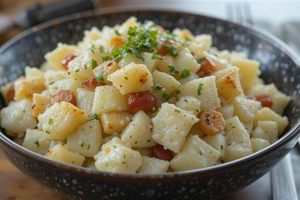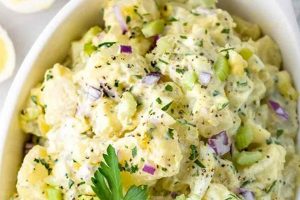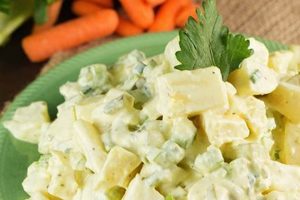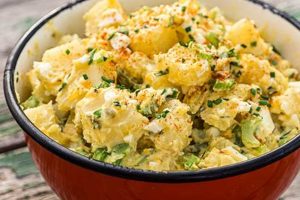Documented instructions for preparing a dish of cooked, diced potatoes combined with other ingredients represent a cornerstone of culinary tradition. Variations abound, incorporating mayonnaise, mustard, vinegar, herbs, spices, and other vegetables, reflecting diverse cultural influences and personal preferences. A simple version might include potatoes, mayonnaise, celery, and onion, while more complex preparations could feature hard-boiled eggs, pickles, or various herbs.
These culinary guides offer a valuable resource for both novice and experienced cooks, preserving and transmitting culinary knowledge across generations. They provide a framework for achieving consistent results, allowing for experimentation and adaptation while ensuring a palatable outcome. The historical evolution of these instructions reflects changing tastes and ingredient availability, offering insights into broader culinary trends. The adaptability of the dish itself contributes to its enduring popularity, suitable for picnics, potlucks, and holiday gatherings.
This exploration will delve into the diverse range of preparation methods, highlighting key ingredients, regional variations, and tips for achieving optimal flavor and texture. From classic preparations to innovative twists, the following sections will provide a comprehensive overview of this versatile culinary staple.
Tips for Potato Salad Success
Achieving optimal flavor and texture in potato salad requires attention to detail throughout the preparation process. The following tips offer guidance for creating a successful dish.
Tip 1: Potato Selection and Cooking: Opt for waxy potatoes, such as red or Yukon Gold, which hold their shape better after cooking. Avoid overcooking, as this can lead to a mushy texture. Cook potatoes until tender but still firm.
Tip 2: Dressing Preparation: Allow the potatoes to cool slightly before adding the dressing. This prevents the dressing from becoming too thin. Emulsifying the dressing separately before adding it to the potatoes can create a smoother, more cohesive texture.
Tip 3: Ingredient Incorporation: Gently fold in delicate ingredients, such as herbs and hard-boiled eggs, to prevent breakage. Adding some of the dressing to the chopped ingredients separately before combining them with the potatoes can help distribute the flavors evenly.
Tip 4: Seasoning and Flavor Balancing: Seasoning should be layered throughout the process. Taste and adjust seasonings after each addition of ingredients. A balance of tanginess, saltiness, and sweetness contributes to a well-rounded flavor profile.
Tip 5: Chilling and Serving: Chilling the potato salad for at least an hour allows the flavors to meld. Garnish before serving with fresh herbs or a sprinkle of paprika for added visual appeal.
Tip 6: Ingredient Variation: Explore different ingredients to create unique flavor combinations. Consider additions such as bacon, roasted peppers, or different types of mustard. Fresh herbs can provide brightness and complexity.
By following these guidelines, one can elevate potato salad from a simple side dish to a culinary highlight. Careful attention to ingredient selection, preparation techniques, and flavor balancing ensures a satisfying and memorable experience.
These insights provide a foundation for crafting exceptional potato salad. The following section will offer concluding thoughts and encourage further culinary exploration.
1. Potato Variety
Potato variety significantly influences the final texture and flavor profile of potato salad. Different potato cultivars possess varying starch content and moisture levels, impacting their behavior during cooking and their interaction with other ingredients. High-starch potatoes, like russets, tend to become fluffy when cooked, making them less suitable for potato salad as they may crumble when mixed with other ingredients. Low-starch, waxy potatoes, such as red potatoes or fingerlings, hold their shape better after cooking, providing a firmer, more desirable texture in the finished salad. Yukon Gold potatoes offer a middle ground, providing a creamy texture while maintaining reasonable structural integrity.
Selecting the appropriate potato variety is crucial for achieving the desired outcome. For a classic American-style potato salad with a mayonnaise-based dressing, waxy potatoes are preferred for their ability to retain their shape and absorb the dressing without becoming mushy. In contrast, a German potato salad, often featuring a vinegar-based dressing and served warm, benefits from the use of slightly higher-starch potatoes that absorb the dressing and offer a softer texture. Choosing the correct potato variety ensures a harmonious balance between flavor and texture, contributing to the overall success of the dish. For instance, using red potatoes in a classic American potato salad will yield a firm, pleasant texture, while using russet potatoes might result in a disintegrated, less appealing salad.
Understanding the characteristics of different potato varieties empowers informed decision-making when preparing potato salad. This knowledge allows for tailoring the recipe to specific preferences and desired outcomes. Considering the interplay between potato variety and other recipe components, such as dressing type and cooking method, contributes to creating a well-balanced and enjoyable culinary experience. Ignoring this crucial element may compromise the final product, leading to textural inconsistencies or flavor imbalances. Therefore, careful selection of the appropriate potato variety is essential for achieving potato salad perfection.
2. Dressing Type
Dressing type significantly influences the overall flavor profile and character of potato salad. The interplay between the dressing and other ingredients, particularly the potatoes and any added vegetables, creates a complex matrix of taste and texture. A creamy, mayonnaise-based dressing, often employed in American-style potato salads, imparts richness and binds the ingredients together, creating a smooth, cohesive texture. Conversely, a vinaigrette-based dressing, commonly used in German or French potato salads, offers a lighter, tangier flavor profile, allowing the individual flavors of the potatoes and other components to shine through. The choice of dressing also impacts the overall moisture content and mouthfeel of the salad. Mayonnaise-based dressings create a denser, creamier salad, while vinaigrette-based dressings result in a lighter, more refreshing dish.
The selection of dressing type should be guided by the desired flavor profile and the other ingredients incorporated into the salad. For example, a robust, Dijon mustard-based dressing complements the addition of hard-boiled eggs and pickles, creating a layered flavor experience. A lighter, herbed vinaigrette harmonizes well with fresh vegetables like celery, red onion, and bell peppers, enhancing their crispness and natural flavors. Furthermore, the choice of dressing can influence the overall serving temperature. Mayonnaise-based dressings are typically served chilled, while vinaigrette-based dressings can be served either chilled or at room temperature, offering greater versatility. A classic example of this differentiation can be seen in comparing a traditional American potato salad, served cold with a mayonnaise-based dressing, to a German potato salad, often served warm with a vinegar and bacon dressing.
Understanding the impact of dressing type on the final product empowers informed decision-making in potato salad preparation. Careful consideration of flavor pairings, desired texture, and serving temperature ensures a well-balanced and enjoyable culinary experience. Furthermore, exploring various dressing types allows for creativity and customization, enabling the creation of unique and personalized potato salad recipes. By mastering this crucial element, one can elevate potato salad from a simple side dish to a culinary centerpiece. The choice ultimately hinges on personal preference and the overall balance of flavors sought within the dish.
3. Added Ingredients
Added ingredients represent a pivotal element in defining the character and complexity of potato salad. These additions contribute not only to flavor diversity but also to textural contrast and visual appeal. The strategic incorporation of complementary ingredients elevates potato salad from a simple starch-based side dish to a multifaceted culinary creation. A classic example is the inclusion of celery and red onion, which introduce a crisp, refreshing counterpoint to the creamy potatoes. Hard-boiled eggs contribute a rich, savory dimension, while pickles offer a tangy, acidic note that balances the richness of mayonnaise-based dressings. The interplay of these added ingredients creates a harmonious blend of flavors and textures, enhancing the overall sensory experience.
The selection and proportion of added ingredients directly influence the final flavor profile of potato salad. Regional variations often highlight specific ingredients, reflecting local culinary traditions and ingredient availability. German potato salad, for instance, frequently incorporates bacon and a vinegar-based dressing, offering a smoky, tangy flavor profile distinct from the creamy, subtly sweet character of American potato salad. Furthermore, the choice of added ingredients can be tailored to personal preferences and dietary restrictions. Substituting traditional mayonnaise with a vegan alternative allows for the creation of plant-based versions, while incorporating roasted vegetables or grilled meats expands the flavor spectrum and nutritional value. A thoughtful approach to ingredient selection allows for endless customization, enabling the creation of potato salads that cater to diverse tastes and occasions. For instance, a Mediterranean-inspired potato salad might include olives, feta cheese, and sun-dried tomatoes, offering a distinctly savory and briny flavor profile.
Understanding the role of added ingredients in shaping the final product is crucial for successful potato salad preparation. Careful consideration of flavor pairings, textural contrasts, and regional influences allows for informed decision-making and culinary creativity. By mastering this key element, individuals can transform a simple side dish into a personalized culinary expression. The choice of added ingredients provides a canvas for experimentation and innovation, enabling the development of potato salad recipes that are both delicious and reflective of individual culinary style. This careful consideration elevates the dish beyond mere sustenance, transforming it into a culinary experience that is both satisfying and memorable.
4. Seasoning Balance
Seasoning balance represents a critical factor in achieving a well-rounded and flavorful potato salad. The interplay of salt, acidity, sweetness, and other seasonings determines the overall taste profile and can elevate the dish from simple to exceptional. Proper seasoning enhances the natural flavors of the ingredients, creating a harmonious blend that satisfies the palate. Achieving this balance requires careful consideration of the other components of the recipe, such as the dressing type and added ingredients, as these elements interact dynamically with the seasonings.
- Salt:
Salt serves as a foundational seasoning, enhancing the flavors of the potatoes and other ingredients. It plays a crucial role in balancing sweetness and acidity, preventing the salad from tasting bland or overly sweet. The amount of salt required depends on the other ingredients and the desired level of saltiness. Kosher salt is often preferred for its clean flavor and ease of use. Adding salt to the potatoes while they are still warm allows for better absorption and even distribution of flavor. Over-salting can ruin a potato salad, masking the subtle flavors of other components. Conversely, under-salting can result in a bland, unappetizing dish.
- Acidity:
Acidity, often introduced through vinegar or lemon juice, provides brightness and balances the richness of mayonnaise-based dressings or the starchiness of the potatoes. It adds a refreshing tang that cuts through the creaminess and prevents the salad from feeling heavy. The type of acid used can also contribute to the overall flavor profile. Apple cider vinegar lends a subtle sweetness, while white wine vinegar offers a sharper, more assertive tang. The amount of acid should be adjusted to complement the other ingredients and achieve the desired level of tartness. For example, a potato salad with a high proportion of dill pickles may require less added acid to avoid excessive tartness. Striking the right balance is essential for a palatable and enjoyable dish.
- Sweetness:
Sweetness, sometimes incorporated through sugar, honey, or sweet pickle relish, adds depth and complexity to the flavor profile. It balances the saltiness and acidity, creating a more well-rounded taste. The level of sweetness should be carefully calibrated to avoid overpowering the other flavors. A touch of sweetness can enhance the savory notes of the other ingredients, while excessive sweetness can make the salad cloying. For instance, a potato salad with a honey mustard dressing may require less added sugar to avoid an overly sweet taste. The judicious use of sweetness contributes to a more nuanced and satisfying flavor experience.
- Other Seasonings:
Beyond salt, acidity, and sweetness, a variety of other seasonings can enhance the complexity and depth of flavor in potato salad. Black pepper adds a subtle spice, while fresh or dried herbs, such as dill, parsley, or chives, contribute aromatic notes and freshness. Mustard powder, celery seed, or paprika can introduce additional layers of flavor. The choice of seasonings should be guided by the other ingredients and the desired overall flavor profile. For example, a German potato salad might incorporate caraway seeds for a distinctive flavor, while a classic American potato salad might include a touch of onion powder to enhance the savory notes. Experimenting with different combinations of seasonings allows for customization and the creation of unique flavor profiles.
The careful orchestration of these seasoning elements is essential for creating a well-balanced and flavorful potato salad. The interplay of salt, acidity, sweetness, and other seasonings determines the overall taste experience and distinguishes a mediocre salad from a truly exceptional one. Achieving the right balance elevates the natural flavors of the ingredients, creating a harmonious and satisfying dish that complements any meal. Mastery of seasoning balance allows for customization and culinary expression, enabling the creation of potato salad recipes that reflect individual tastes and preferences.
5. Preparation Method
Preparation method significantly influences the final texture, flavor, and overall quality of potato salad. Different techniques impact the ingredients’ interaction, affecting the dish’s cohesiveness, taste, and visual appeal. Understanding these nuances allows for informed decision-making, enabling the creation of potato salad tailored to specific preferences and desired outcomes.
- Potato Cooking Technique:
The method employed for cooking potatoes impacts their texture and their ability to absorb dressings and seasonings. Boiling potatoes until tender but firm is crucial for achieving the desired texture in most potato salad recipes. Overcooked potatoes become mushy and disintegrate when mixed with other ingredients, while undercooked potatoes remain firm and resistant to flavor absorption. Steaming potatoes preserves their nutrients and results in a drier texture, advantageous for salads with lighter, vinaigrette-based dressings. Roasting potatoes before incorporating them into the salad adds a smoky depth of flavor and a slightly caramelized texture, offering a unique twist on traditional preparations. For instance, roasted red potatoes with a Dijon mustard vinaigrette create a robust and flavorful salad.
- Dressing Incorporation:
The timing and method of dressing incorporation significantly impact the final texture and flavor distribution within the salad. Adding dressing to warm potatoes allows for greater absorption, resulting in a more cohesive and flavorful dish. However, adding a mayonnaise-based dressing to hot potatoes can cause the dressing to thin and separate. Cooling the potatoes slightly before adding the dressing prevents this issue while still allowing for adequate flavor penetration. Gently folding the dressing into the potatoes, rather than vigorously mixing, prevents the potatoes from breaking down and maintains a desirable texture. For example, incorporating a herbed vinaigrette into warm, steamed potatoes ensures even distribution of flavor and a light, refreshing texture.
- Ingredient Combination Order:
The sequence in which ingredients are combined influences the final flavor profile and textural harmony of the salad. Adding more delicate ingredients, such as fresh herbs or hard-boiled eggs, towards the end of the preparation process prevents them from being crushed or over-mixed. Incorporating some of the dressing into the chopped vegetables before combining them with the potatoes ensures even flavor distribution. For instance, mixing chopped celery and red onion with a portion of the dressing before adding them to the potatoes creates a more balanced and flavorful salad.
- Chilling Time:
The duration and temperature of chilling significantly affect the flavor development and overall enjoyment of potato salad. Chilling allows the flavors of the various ingredients to meld and intensify, creating a more complex and harmonious taste profile. A minimum chilling time of one hour is generally recommended, but longer chilling periods, up to several hours, can further enhance the flavor development. However, excessive chilling can dull the flavors and make the potatoes firm. The ideal chilling temperature is between 35-40F (2-4C), which allows for optimal flavor development without freezing the salad. For example, allowing a classic American potato salad to chill overnight in the refrigerator allows the flavors of the potatoes, mayonnaise, celery, and onions to meld, creating a richer and more cohesive taste experience.
These facets of preparation method are integral to crafting a successful potato salad. The considered application of these techniques, guided by the specific recipe and desired outcome, ensures a dish that is both flavorful and texturally pleasing. Each step, from potato preparation to chilling time, contributes to the final product, highlighting the importance of meticulous preparation in achieving potato salad perfection.
6. Serving Temperature
Serving temperature significantly impacts the sensory experience of potato salad, influencing flavor perception, textural appreciation, and overall enjoyment. Temperature affects the volatility of aromatic compounds, impacting the intensity of perceived flavors. It also influences the texture of the ingredients, particularly the potatoes and the dressing. A chilled potato salad offers a refreshing, crisp texture, while a warm potato salad presents a softer, more yielding consistency. The optimal serving temperature depends on the specific recipe and the desired balance of flavors and textures. A classic American potato salad, with its mayonnaise-based dressing, is typically served chilled, enhancing the creamy texture of the dressing and the refreshing quality of the other ingredients. In contrast, a German potato salad, often featuring a vinegar and bacon dressing, can be served warm, highlighting the smoky flavors of the bacon and the tangy notes of the vinegar. Serving a mayonnaise-based potato salad at room temperature can compromise the integrity of the dressing, leading to a less desirable texture and potential food safety concerns. Conversely, serving a warm German potato salad chilled can mask the subtle nuances of flavor and result in a less satisfying experience.
Understanding the interplay between serving temperature and the other components of a potato salad recipe, such as the dressing type and added ingredients, is crucial for achieving optimal enjoyment. A mayonnaise-based dressing firms up when chilled, contributing to the desired texture of a cold potato salad. Serving this type of salad warm can make the dressing oily and less palatable. Conversely, a vinaigrette-based dressing maintains its fluidity at both warm and cold temperatures, offering greater flexibility in serving temperature. The addition of certain ingredients, such as hard-boiled eggs or crisp vegetables, is also influenced by the intended serving temperature. Hard-boiled eggs retain their firm texture when chilled, while certain vegetables, like celery and red onion, maintain their crispness when served cold. Serving these ingredients in a warm potato salad can alter their textural characteristics and potentially compromise the overall balance of the dish. For instance, a chilled potato salad with crisp celery and a creamy mayonnaise dressing offers a refreshing contrast of textures, while a warm potato salad with wilted celery and a runny mayonnaise dressing provides a less appealing sensory experience.
Appropriate serving temperature enhances the overall culinary experience of potato salad. Careful consideration of the recipe’s components and the desired balance of flavors and textures guides the selection of the optimal serving temperature. Adhering to recommended serving temperatures ensures food safety and maximizes enjoyment, allowing the carefully crafted flavors and textures of the salad to shine. Neglecting this aspect can compromise the intended sensory experience, diminishing the culinary artistry and potentially leading to food safety risks. Therefore, understanding and applying the principles of serving temperature is essential for achieving potato salad perfection, transforming a simple side dish into a culinary delight.
7. Storage Techniques
Proper storage techniques are essential for maintaining the quality, flavor, and safety of potato salad. Because potato salad often contains ingredients like mayonnaise, eggs, and potatoes, it is highly susceptible to bacterial growth and spoilage if not stored correctly. Improper storage can lead to off-flavors, textural changes, and, most importantly, foodborne illness. Effective storage practices preserve the intended flavor profile, maintain the desired texture, and mitigate the risk of bacterial contamination. For example, storing potato salad in an airtight container at or below 40F (4C) inhibits bacterial growth and maintains the quality of the ingredients. Conversely, leaving potato salad at room temperature for extended periods, especially in warm environments, creates ideal conditions for bacterial proliferation, potentially leading to foodborne illness.
Different potato salad recipes may require specific storage considerations based on their ingredients and preparation methods. Salads with mayonnaise-based dressings are more perishable than those with vinaigrette-based dressings and require stricter adherence to refrigeration guidelines. The inclusion of ingredients like hard-boiled eggs or cooked meats further increases the perishability and necessitates prompt refrigeration. Understanding these nuances allows for tailored storage practices that maximize shelf life and maintain food safety. For instance, a potato salad containing hard-boiled eggs and a mayonnaise-based dressing should be refrigerated immediately after preparation and consumed within three to five days. A potato salad with a vinaigrette-based dressing and no eggs or meat can be stored in the refrigerator for up to a week. Furthermore, freezing potato salad is generally not recommended, as the freezing and thawing process can negatively impact the texture of the potatoes and the consistency of the dressing, leading to a less desirable final product. Freezing can cause the potatoes to become watery and the mayonnaise-based dressing to separate.
Implementing appropriate storage techniques safeguards the quality and safety of potato salad. Adherence to recommended refrigeration temperatures and storage durations preserves the intended flavor profile, maintains desirable texture, and minimizes the risk of foodborne illness. Understanding the specific storage requirements of different potato salad recipes, based on their ingredients and preparation methods, allows for informed decision-making and safe consumption. Neglecting proper storage practices can compromise both the culinary experience and consumer well-being, underscoring the critical role of storage in maintaining the quality and safety of this popular dish.
Frequently Asked Questions
This section addresses common inquiries regarding the preparation and enjoyment of potato salad, offering concise and informative responses to facilitate culinary success and enhance understanding.
Question 1: What is the best type of potato to use for potato salad?
Waxy potatoes, such as red or Yukon Gold, are generally preferred for potato salad due to their ability to hold their shape after cooking. They absorb dressings well without becoming mushy.
Question 2: How long should potato salad be chilled before serving?
Chilling potato salad for at least one hour allows the flavors to meld. Longer chilling times, up to several hours, can further enhance flavor development, but avoid excessive chilling, which can dull the flavors.
Question 3: Can potato salad be frozen?
Freezing is generally not recommended, as it can negatively impact the texture of the potatoes and the consistency of the dressing.
Question 4: How long can potato salad be stored in the refrigerator?
Potato salad with mayonnaise-based dressings should be refrigerated and consumed within three to five days. Vinaigrette-based versions without eggs or meat can last up to a week when properly refrigerated.
Question 5: What causes potato salad to become watery?
Wateriness can result from overcooked potatoes, adding dressing to hot potatoes, or not properly draining the potatoes after cooking.
Question 6: How can one prevent potato salad from becoming too tangy?
Balance acidity with sweetness and salt. Adjust the amount of vinegar or lemon juice, and consider adding a touch of sugar or sweet pickle relish to counteract excessive tanginess.
Careful attention to these frequently asked questions ensures optimal potato salad preparation and storage, promoting both enjoyment and food safety. Understanding these aspects contributes to a more informed and successful culinary experience.
The following section offers a collection of diverse potato salad recipes, catering to various tastes and culinary preferences.
Culinary Exploration of Potato Salad Recipes Concludes
Documented instructions for creating potato salad offer a versatile framework for culinary expression. Examination of key elementspotato variety, dressing type, added ingredients, seasoning balance, preparation method, serving temperature, and storage techniquesreveals the nuanced interplay contributing to a successful outcome. Careful consideration of these factors allows for adaptation and customization, enabling the creation of potato salads tailored to individual preferences and diverse culinary traditions. From classic preparations to innovative variations, adherence to established principles ensures both enjoyment and food safety.
The enduring popularity of potato salad underscores its adaptability and enduring appeal. Continued exploration of flavor profiles, ingredient combinations, and regional variations promises further culinary innovation. A thoughtful approach to preparation, informed by established culinary principles, elevates this seemingly simple dish to a culinary art form, offering a canvas for creativity and a testament to the enduring power of culinary tradition.






